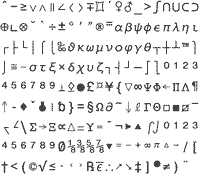
We’ve all been exposed to different types of character encoding while using
the Internet. Some of these include
ASCII,
ANSI,Latin-1,
ISO 8859-1,
Unicode,
UTF-7,
UTF-8,
UCS-2,
URL-encoding, etc. There are a lot of them, and for many it’s very difficult to
remember the differences between these standards, and when to use one vs.
the other.
So let’s fix that. Permanently. Here, now, on one page.
Encoding
is simply the process oftransforming information from one format into
another. It’s not magic, it’s not hard, andhaving a good understanding of
the topic will help you a lot in the IT field. In this
study
piece I’ll be covering both the underlying concepts as well as providing a
quick reference for the most commonly used standards.
Concepts
The best way to quickly grasp the basics of character encoding is to start
with how
ASCII
came to be.
-
When UNIX and C were being developed there was
only a need for unaccentedEnglish characters. As such, ASCII was
created so that everything English (and theunprintable stuff like spaces
and
linefeeds) could fit in 127 places, which tookup just 7 bits (0-127). -
But since computers were using 8-bit bytes,
various governments and groupsstarted thinking up of things to do
with the other 128 places
(128-255). The problemis that they didn’t agree on what to do with them,
and chaos ensued. The result was thatdocuments sent from system to
system often could not be read because they were usingdifferent
character standards. -
Finally, the IBM (OEM) and ANSI (Microsoft) systems were created, which
defined
code pages
that consisted of ASCII for the bottom 127 characters andthen a given
language variation for the top 128 characters. So code pages 437 (IBM),
737 (Greek), 862 (Turkish), etc., were all 256 characters each, with
ASCII as the first 127 and then their respective language for the other
128. This wayanyone using the same code page would be able to exchange
documents without having hiscontent mangled.
This system of hotswapping code pages limped along until the Internet
connected everyone and proved a) 8 bits aren’t enough, and
b) exchanging text between systems all over the world is going to be
the norm, not the exception. That lead to a fundamental shift in how
encoding is accomplished. That brings us to the following:
It’s helpful to think of encoding methods as falling into two main
categories–the old way and the new way.
-
The Old Way: Each character has a
specific and direct representation on a computer. -
The New Way: Each character is a concept, and can be represented
in multiple ways.
The Old Way
As mentioned,
ASCII
is one of the first types ofencoding, and it uses the old way. In other
words, ASCII characters are stored in a fixed number of bits in memory-all
the time, every time. So an ASCII “D” always looks like this on a
computer:
0100 0100

…which is 68 in decimal, and 44 in hex, etc. The problem with this approach
is that it doesn’t scale. 8 bits only hold 256 combinations, and while
English only has 26 characters in its alphabet (52 for capitals), you still
need to add symbols, numbers, non-printable characters, etc. And that’s just
English. Once you start adding all the other languages, many of which use
accented and other special types of characters, 256 becomes a very low
number.
The New Way
The newer, better solution is to not map characters directly at all, and to
instead map them to a very specific conceptual entity which can then
be described by a computer in multiple ways (using more bits/bytes as
needed). This is what
Unicode
does–it maps every letter of every language to a unique number (called a
code point), so an upper-case “D” in Unicode maps to:
U+0044
This is always the case (sorry) regardless of the font used. One concept
(letter) to one code point. So an upper-case “D” is always
U+0044, and a lowercase “d” is not simply a “D” that
looks different–it’s a completely different entity with its own number
(U+0064). The numbers after the u+ are always in
hex. So now that you have set of individual numbers (code points) for
characters you can decide how to handle them using a computer. This is the
encoding part, which we’ll cover below in the standards section.
The key distinction between the old way and the new way is that the old way
combined the characters themselves with how they were represented on a
computer, whereas the new system decouples these pieces.
So in ASCII, for example, the letter “D” is always 7 bits, just like
any other English letter, but in Unicode the letter “D” is just an
idea that can be represented on a computer in a variety of ways.
This difference between the old and new systems is key to understanding
character encoding.
EBCDIC,
ASCII, and
code pages
are all examples of this old system of mapping directly to integers that are
stored in a fixed way.
Unicode
and the
Universal Character Set
are examples of the new system that makes a distinction between identity and
representation.
A Note About “Plain Text”
Before proceeding we should address the concept of “plain text”. “Plain
Text” is a misnomer; it doesn’t actually exist. Talking about “plain” text
with reference to a computer is like going into a supermarket and asking for
“regular” food, or asking someone who speaks 200 languages to speak
“normally”. In short, the words regular, normal, and “plain” are all
subjective, and computers don’t like subjective.
Email and Web Encoding Declarations (respectively)
The only way to describe how something is encoded to a computer is to tell
it what standard to use. Period. Always explicitly define encoding in your
documents; it will reduce by a significant margin the number of unexpected
outcomes you experience.
The Standards
Below I give some information on the common character encoding standards.
I’ll do so in a repeating format that covers history, characteristics, and
any references for the standard.
ASCII (American Standard Code for Information Interchange)

History:
ASCII
is one of the first computerized character systems in the world (after
EBCDIC). Initially an English-only and non-accented character system used back
when the C programming language and UNIX operating systems were being
created.
Characteristics: This is a 7-bit system (0-127). Characters from 0-31
are non-printable, and from 32-127 are the standard characters that people
often mistakenly call “plain text”.
Reference:
The ASCII Standard (wikipedia.org),
ASCII Table.
Extended ASCII

History: Extended ASCII is something of an informal name. It really just
refers to how various groups handle the top 128 characters above the
commonly accepted ASCII. So any system that’s compatible with ASCII for the
first 0-127 characters, but has more above that, is considered “extended”
ASCII.
Characteristics: Again, there isn’t really a strong definition of what
“extended” ASCII is since it’s kind of a misnomer. Any character system that
has content between 128 and 256 in addition to 0-127 is considered to be an
implementation of extended ASCII. These include both
code pages
and
Unicode.
Reference:
Extended ASCII (wikipedia.org)
IBM Code Pages

History: IBM Code Pages (also called OEM Code Pages) were created by IBM as
a solution to everyone using the unused 8th bit in ASCII for their own
purposes and causing confusion. They created a set of code mappings that
included standard ASCII as the bottom 128 characters, but then various
languages in the top 128, e.g.
Greek,
Turkish,
Hebrew,
etc. IBM code page
437
is the original character set for the IBM PC.
Characteristics: Code Pages contain the full 256 characters available from
an 8-bit system, and include the agreed-upon ASCII at the bottom 127 (with
some occasional variation) and then the top 128 vary based on the language,
as indicated by the name. So the IBM code page
869, for example, is Greek in the top half and ASCII in the lower half–making
a total of 256 characters.
Reference:
IBM Code Page Reference (ibm.com)
ANSI Code Pages

History: The ANSI Code Pages are sets of characters very similar to IBM’s
Code Pages, but were used in Microsoft operating systems. The name “ANSI” is
interesting, as it implies that the mappings are standardized by ANSI, but
they aren’t. The name came because
ANSI Code Page 1252
was supposedly based on a draft submitted to ANSI, but to this day ANSI has
not made any of the “ANSI” standards official. So they’re best thought of as
Microsoft standards.
Characteristics: ANSI Code Pages, like their IBM counterparts, contain the
full 256 characters available from an 8-bit system, and include the
agreed-upon ASCII at the bottom 127 (with some occasional variation) and
then the top 128 vary based on the language, as indicated by the name. So
the ANSI code page
1256, for example, is Arabic in the top half and ASCII in the lower half–making
a total of 256 characters.
Reference:
ANSI Code Pages
(wikipedia.org)
Unicode

History:
Unicode
is the result of a herculean effort to build a single code mapping (and
encoding) system able to be used universally around the world. It was
designed to replace
code pages, which are various language-specific character mappings of 256 characters
each. The first version of Unicode was launched in 1988, created by
representatives of Xerox and Apple.
Characteristics: As covered in the
concepts
section (I recommend reading that first), it’s important to understand that
Unicode separates character mapping from character encoding. On the mapping
side, Unicode maps virtually every letter or symbol, in every language, to a
unique code point, each of which is described by a U+ followed by four
characters of
hex, e.g. the uppercase English letter “D” is represented by
U+0044. Unicode defines 1,114,112 (220+216) individual code points in
this way.
UTF-8/16/32
For the encoding side, Unicode has numerous ways of converting these code
points into actual bits and bytes on a computer; these are called
Unicode Transformation Formats
(UTFs). You’ve no doubt come across
UTF-8
in your travels, and that’s one option. But UTF-8 is not the only way you
can encode a capital “D” (U+0044) in Unicode. Here’s a table that shows some
alternatives:
unicode.org
The chart above reveals another misconception about Unicode: the “8” in
“UTF-8” doesn’t indicate how many bits a code point gets encoded into.
The final size of the encoded data is based on two things: a) the
code unit size, and b) the number of code units used. So the 8 in
UTF-8 stands for the code unit size, not the number of bits that will
be used to encode a code point.
unicode.org
Image from: http://www.cl.cam.ac.uk/~mgk25/unicode.html
So now we see that UTF-8 can actually store a code point using between one
and four bytes. I find it helpful to think of the code unit size as the
“granularity level”, or the “building block size” you have available to you.
So with UTF-16 you can still only have four bytes maximum, but your code
unit size is 16 bits, so your minimum number of bytes is two.
As an example of the various ways to encode the same content different ways,
here is a chart that shows various ways you can encode English’s unaccented
capital “D”.
fileformat.info
Get a weekly breakdown of what’s happening in security and tech—and why it matters.
UCS Encoding

History: The Universal Character Set (UCS) is described in
ISO/IEC Standard 10646, and was begun in 1989. Since 1991 the
Unicode Consortium
has worked with ISO to develop The Unicode Standard and ISO/IEC 10646 in
parallel. The character set, character names, and code points of Unicode
exactly match UCS (with very few exceptions).
Characteristics: The UCS standard is basically a sister standard to
Unicode; they are extremely similar. The differences lie in the fact that UCS is
an ISO standard while Unicode is backed by the Unicode Consortium, and
Unicode supports a number of additional features beyond UCS, e.g.
right-to-left language support.
Again, keep in mind that UCS/Unicode can be used interchangeably in many
scenarios. Here is how their standards map to each other:
UCS to Unicode Mapping
UCS-2/4
UCS-2
is an obsolete system that’s often confused with UTF-16. There is confusion
because UCS-2 always used two (2) bytes per character, and the original
concept for Unicode was two bytes per character as well, but that’s not the
case now. UTF-16 has a minimum encoding of two bytes for any code
point, but UTF-16 can use more than 2 bytes per character (up to four)
because it supports surrogate pairs (pairs of 16-bit words).
In short, UCS-2 was a fixed-length encoding scheme with
all code points encoding to two bytes, and UTF-16 is
variable-length with two bytes as a minimum. But because they
both had something to do with “two bytes” they often get confused.
It’s a moot point anyway since UCS-2 is obsolete; if you need a 16 bit base,
always use UTF-16.
UCS-4
is identical, from a character mapping standpoint, to
UTF-32. Both are fixed-length encoding schemes that encode every
UCS/Unicode code point to 32 bits.
Reference:
The Universal Character System (UCS) (ISO 10646) (wikipedia.org)
UTF-7
History: SMTP specifies that data be transmitted in ASCII, and doesn’t allow
bytes above the standard 0-127 range. The goal of UTF-7 was to make a system
for encoding Unicode characters below 128 in a format that would pass
through a classic SMTP implementation without being mangled.
Characteristics: UTF-7 is a 7-bit variable-length encoding system.
It’s called UTF, but it’s not actually a Unicode standard itself. It encodes
only the characters below 128 (it only has 7 bits to work with) by using one
of two methods: For approximately 65 of the ASCII characters UTF-7 encodes
them directly into the ASCII representation. For the rest it converts the
character to UTF-16 and then performs
Modified Base 64 Encoding
on them. From Wikipedia,
the actual steps
are:
-
Express the UTF-16 characters in binary
-
Concatenate the binary sequences
-
Regroup the bits into groups of six
-
If the last group has less than six, add zeros
-
Replace each group of six bits with a Base64 code
Reference:
UTF-7 (wikipedia.org)
ISO 8859

History:
ISO 8859
is an early ISO standard (before UCS/Unicode) that attempted to unify code
mapping systems.
Characteristics: ISO 8559 is an 8 bit system that groups various
alphabets into
parts, which are then named 8859-1, 8859-2, etc. Here’s how they break down:
-
Part 1: Latin-1 | Western European
-
Part 2: Latin-2 | Central European
-
Part 3: Latin-3 | South European
-
Part 4: Latin-4 | North European
-
Part 5: Latin-Cyrillic
-
Part 6: Latin-Arabic
-
Part 7: Latin-Greek
-
Part 8: Latin-Hebrew
-
Part 9: Latin-5 | Turkish
-
Part 10: Latin-6 | Nordic
-
Part 11: Latin-Thai
-
Part 13: Latin-7 | Baltic Rim
-
Part 14: Latin-8 | Celtic
-
Part 15: Latin-9
-
Part 16: Latin-10 | South-Eastern European
This standard is pretty much obsoleted by UCS/Unicode. It’s like the
standard that ISO wishes never happened. Avoid it when possible and use
Unicode instead.
Reference:
ISO 8859 (wikipedia.org)
URL Encoding

History: RFC 1738 (the standard for URLs) dictates that “Only alphanumerics
[0-9a-zA-Z], the special characters– $-_.+!*'(), –and reserved characters
used for their reserved purposes may be used unencoded within a URL.” HTML
allows any character in the ISO 8559-1 character set, and HTML 4 allows for
anything in Unicode.
Characteristics: As a result of this requirement for URLs many common
character sets cannot be used. All of ASCII can’t be used becauase much of
it is unprintable. “Extended” ASCII (128-256) can’t be used because it’s not
in the standard ASCII set. And some characters are simply a bad idea to use
because it’s too easy to confuse them within URLs. Here’s a list of these
from
bloobery’s excellent page:
-
Space
-
Quotes “”
-
Less Than “
-
Greater Than “>”
-
Pound “#”
-
Curley Braces {}
-
The Pipe Symbol |
-
The Backslash
-
The Carat ^
-
The Tilde ~
-
Brackets [ ]
-
The Command Tick `
For any of these characters listed that can’t (or shouldn’t be) be put in a
URL natively, the following encoding algorithm must be used to make it
properly URL-encoded:
-
Find the
ISO 8859-1 code point for the character in question -
Convert that code point to two characters of hex
-
Append a percent sign (%) to the front of the two hex characters
This is why you see so many instances of %20 in your URLs. That’s the
URL-encoding for a space.
Reference:
The W3C URL Encoding Reference,
URL Encoding (bloobery.com)
FAQ

Here I’ll try and address a number of common questions in question/answer
format. If you have the time, however, I suggest you check out the
concepts
and/or
standards
sections first.
What’s the difference between Unicode and UCS (ISO 10646)?
Think of Unicode and UCS as basically the same when it comes to character
mapping. They almost mirror each other in this regard. Unicode, however,
adds a number of features such as the ability to properly render
right-to-left scripts, perform string sorting and comparison, etc. If ever
in doubt you probably want to use Unicode.
What is the basic multilingual plane (BMP)?
The
BMP
is one of 17 sets of the total Unicode code space. It is the first one
(plane 0), and has the most character assignments. Its purpose is to unify
the character sets of all previous systems, and to support all writing
systems currently being used.
I’m confused. Which schemes encode to which lengths?
-
ASCII -> 7 bits
-
“Extended ASCII” -> 8 bits
-
UTF-7 -> 7 bits
-
IBM (OEM) Code Maps -> 8 bits
-
ANSI (Microsoft) Code Maps -> 8 bits
-
ISO 8859 -> 8 bits
-
UTF-8 -> 1-4 bytes
-
UTF-16 -> 2-4 bytes
-
UTF-32 -> 4 bytes
-
UCS-2 -> 2 bytes (obsolete)
-
UCS-4 -> 4 bytes
Conclusion
I hope this has been helpful, and if you have any questions, comments, or
corrections, please feel free to either comment below or
contact me
directly. I’m also considering this my first draft, so if you have anything
I should add to any of the sections to make it easier to understand, do let
me know.












0 responses on "Same Origin Policy"